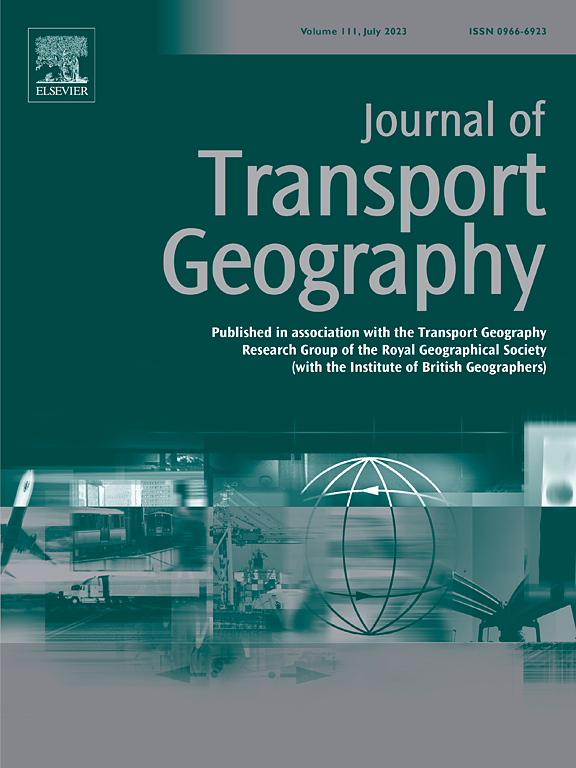Spatio-temporal dynamic characteristics of the substitution effect of ride-hailing travel and its multi-activity network: a case study of Chengdu
IF 5.7
2区 工程技术
Q1 ECONOMICS
引用次数: 0
Abstract
The substitution relationship between ride-hailing and public transit significantly impacts urban transport carbon emissions. However, a quantitative analysis exploring the spatio-temporal dimensions of the substitution effect between these two modes of transport is still lacking. Furthermore, the motivations for travel and the associated activity networks remain unclear. This study proposes a spatio-temporal measure of the substitution effect of ride-hailing travels by introducing demand elasticity theory and big data technology to address these limitations. It explores the multi-activity network of the substitution effect and its community clustering features using an improved trip purpose identification method and complex network techniques. An empirical study in Chengdu, China, revealed a significant substitution influence of ride-hailing for public transport in central urban areas. Specifically, 28.69 % and 27.08 % of ride-hailing trips substituted public transport on weekdays and weekends, respectively. Regarding temporal variation, the substitution rate fluctuates dynamically with travel time and motivation changes and increases significantly during peak hours. Non-subsistence travel activities are the dominant type of substitute trips, while subsistence activities occur primarily during weekday peak hours. The complex network models reveal that the activity network of substitution effects exhibits significant spatial heterogeneity, hierarchy, and dependency characteristics. This research also confirms that differences in residents' travel patterns cause the coexistence of a monocentric and polycentric structure in the city. Furthermore, the community structure of substitute trips reveals that communities can shrink, disappear, or emerge depending on various temporal scenarios. These findings provide a basis for determining residential activity boundaries and travel circles. The study deepens the understanding of the dynamic interaction of the “substitution effect-multiple activity network-urban spatial structure” of travel modes. It provides valuable empirical evidence to enhance the competitiveness of public transport and more effectively regulate ride-hailing services. This holds significant practical value for sustainable urban development.
网约车出行及其多活动网络替代效应时空动态特征——以成都市为例
网约车与公共交通的替代关系显著影响城市交通碳排放。然而,对这两种运输方式之间替代效应的时空维度的定量分析仍然缺乏。此外,旅行的动机和相关的活动网络仍不清楚。本研究通过引入需求弹性理论和大数据技术来解决这些局限性,提出了网约车替代效应的时空度量。利用改进的出行目的识别方法和复杂网络技术,探讨了替代效应的多活动网络及其社区聚类特征。在中国成都进行的一项实证研究表明,网约车对中心城区的公共交通具有显著的替代影响。具体来说,在工作日和周末,打车出行取代公共交通的比例分别为28.69%和27.08%。在时间变化方面,替代率随出行时间和出行动机的变化而动态波动,在高峰时段显著增加。非生计旅行活动是主要的替代旅行类型,而生计活动主要发生在工作日的高峰时间。复杂网络模型表明,替代效应的活动网络具有显著的空间异质性、层次性和依赖性特征。研究还证实了居民出行方式的差异导致了城市单中心与多中心结构的共存。此外,替代出行的社区结构表明,社区可以根据不同的时间情景收缩、消失或出现。这些发现为确定居住活动边界和旅游圈提供了依据。该研究加深了对出行方式“替代效应-多元活动网络-城市空间结构”动态交互作用的认识。它为提高公共交通的竞争力和更有效地监管网约车服务提供了宝贵的经验证据。这对城市可持续发展具有重要的实践价值。
本文章由计算机程序翻译,如有差异,请以英文原文为准。
求助全文
约1分钟内获得全文
求助全文
来源期刊

Journal of Transport Geography
Multiple-
CiteScore
11.50
自引率
11.50%
发文量
197
期刊介绍:
A major resurgence has occurred in transport geography in the wake of political and policy changes, huge transport infrastructure projects and responses to urban traffic congestion. The Journal of Transport Geography provides a central focus for developments in this rapidly expanding sub-discipline.
 求助内容:
求助内容: 应助结果提醒方式:
应助结果提醒方式:


